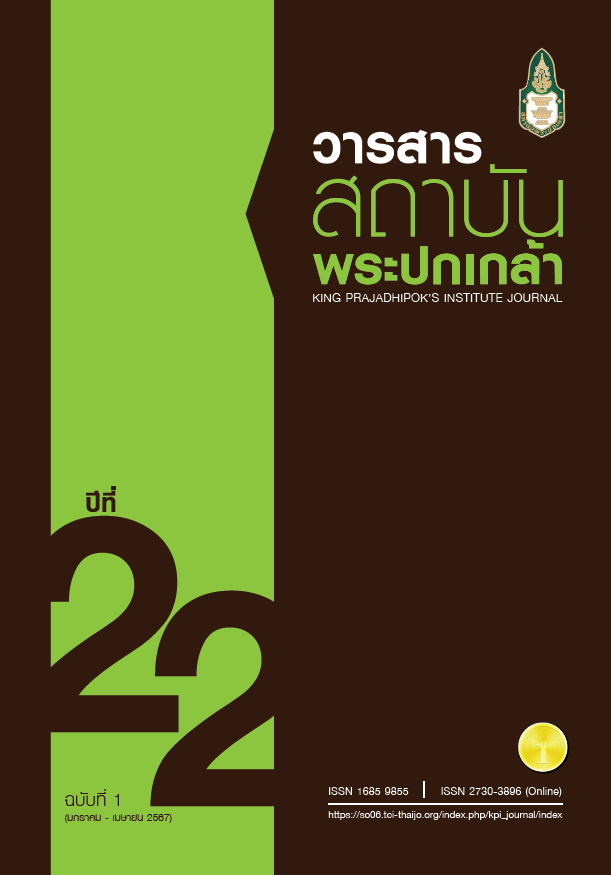Development of Educational Curriculum for Promoting Civic Engagement within a Democratic Regime under the Constitutional Monarchy of Uttaradit province
Main Article Content
Abstract
This article is part of the research findings on the topic of “Development of Education Curriculum for Promoting Civic Engagement within a Democratic Regime under the Constitutional Monarchy with Participation of the Local Networks to Formulate Policy Suggestion for Supporting Civic Development in Uttaradit Province” The research objectives include:
1) To develop the educational curriculum to promote civic engagement within a democratic regime under the constitutional monarchy with the participation of the local networks;
2) To examine and evaluate the outcomes of using the curriculum and
3) To formulate policy suggestions for civic development within a democratic regime under the constitutional monarchy for people in Uttaradit province.
This research used a mixed-method approach. The qualitative component involves 45 informants, utilizing methods consist of in-depth interviews, focus group discussions, and a pilot curriculum. The data analysis included content analysis and deductive analysis. The quantitative comprised a population of 30 individuals. Data collection was conducted using a questionnaire with a 5-point Likert scale. Data analysis was carried out using inferential statistics, which included frequency, mean, and S.D. The research findings are summarized as follows:
The research results according to the first objective found that the characteristics of citizens identified for curriculum development can be categorized into 6 groups: 1) Understanding of the Governance 2) Respect and Acceptance of Laws and Regulations in Society 3) Participation and Accountability 4) Understanding of the Monarch's role in a Democratic Constitutional Monarchy 5) Ethical Principles and 6) Other Characteristics, such as rationality.
Regarding curriculum development, it was discovered that the curriculum is named “Civic Engagement Curriculum in a Democratic Constitutional Monarchy in Uttaradit Province”. The curriculum structure consists of a total of 96 hours (6 credits), organized into the following content groups: 1) Core Content; 2) Local Content; 3) Specialized Content and 4) Project. The results of the second objective revealed that the overall average value of the curriculum usage is at the highest level. It is found that the aspects of learning outcomes and behaviors have the highest average value. The teaching methods, curriculum, structure, and content have comparatively lower average values among the three aspects.
The results of the third objective provided the following 4 suggestions: 1) Enhance knowledge, understanding, and awareness of citizenship within a democratic regime under the constitutional monarchy of Uttaradit province for the whole people in Uttaradit province through a citizenship educational curriculum. 2) Encourage to establishment of a credit bank system in collaboration with academic institutions to enhance lifelong learning. 3) Provide equal opportunities for all interested learners without any restrictions or conditions and 4) Develop a public policy from an educational curriculum for promoting civic engagement within a democratic regime under the constitutional monarchy of Uttaradit province.
Article Details

This work is licensed under a Creative Commons Attribution-NonCommercial-NoDerivatives 4.0 International License.
@ 2020 King Prajadhipok's Institute The Government Complex Commemorating All Right Reserved.
References
ภาษาไทย
ชัยนิตย์ พรรณาวร และรุจิร์ ภู่สาระ. (2556). การพัฒนาหลักสูตรการเป็นพลเมืองดีสำหรับเยาวชน. วารสารวิชาการมหาวิทยาลัยอีสเทิร์นเอเชีย, 3(2), 97-103.
ทิพย์พาพร ตันติสุนทร. (2557). พลเมือง สิทธิมนุษยชน และประชาธิปไตย. กรุงเทพฯ: สถาบันนโยบายศึกษา ภายใต้มูลนิธิส่งเสริมนโยบายศึกษา.
ปริญญา เทวานฤมิตรกุล. (2555). การศึกษาเพื่อความเป็นพลเมือง (Civic Education) : แก้ปัญหาการเมืองไทยโดยสร้างประชาธิปไตยที่ “คน”. ใน เอกสารประกอบการประชุมวิชาการสถาบันพระปกเกล้าครั้งที่ 13 ประจำปี 2554 เล่ม 2 ความเป็นพลเมืองกับอนาคตประชาธิปไตยไทย (Citizenship and the Future of Thai Democracy) (น. 243 - 265). กรุงเทพฯ: สถาบันพระปกเกล้า.
พนารัตน์ วิทยอนันต์. (2563). การจัดการศึกษาเพื่อเสริมสร้างความเป็นพลเมืองดีของนักเรียนโรงเรียนสังกัดเทศบาลนครนครราชสีมา. วารสารวิทยาลัยนครราชสีมา, 12 (1), 293-301.
เพ็ญณี กันตะวงษ์ และศิวัช ศรีโภคางกุล. (2563). การศึกษาเพื่อความเป็นพลเมืองในประเทศสหรัฐอเมริกา. วารสารมนุษย์กับสังคม คณะมนุษยศาสตร์และสังคมศาสตร์ มหาวิทยาลัยมหาสารคาม, 6(1), 111-130.
มหาวิทยาลัยราชภัฏอุตรดิตถ์, กองนโยบายและแผน. (2565). แผนยุทธศาสตร์การพัฒนามหาวิทยาลัยราชภัฏอุตรดิตถ์ ปีงบประมาณ พ.ศ. 2565 - 2569. สืบค้นจาก https://plan.uru.ac.th/download/y65_69.pdf
วรากรณ์ สามโกเศศ. (2554). การศึกษาเพื่อสร้างความเป็นพลเมือง. สืบค้นจาก https://www.moe.go.th/การศึกษาเพื่อสร้างความ/
วิลาพัณย์ อุรบุญนวลชาติ และอรพิณ ศิริสัมพันธ์. (2562). การพัฒนาหลักสูตรเพื่อเสริมสมรรถนะการจัดการเรียนรู้สำหรับนักศึกษาครูประถมศึกษาเพื่อพัฒนาคุณลักษณะความเป็นพลเมืองของนักเรียนประถมศึกษา. วารสารศิลปากรศึกษาศาสตร์วิจัย, 11(2), 306-323.
ศรัณยุ หมั้นทรัพย์. (2551). การศึกษาเพื่อสรางพลเมือง : ฐานรากของการเมืองภาคพลเมือง. วารสารสถาบันพระปกเกล้า, 6(2),1 -16.
ศูนย์พัฒนาการเมืองภาคพลเมือง สถาบันพระปกเกล้าจังหวัดอุตรดิตถ์. (2565). รายงานผลการดำเนินโครงการโรงเรียนพลเมือง ประจำปี 2565. อุตรดิตถ์: ศูนย์พัฒนาการเมืองภาคพลเมือง สถาบันพระปกเกล้าจังหวัดอุตรดิตถ์.
ศูนย์พัฒนาการเมืองภาคพลเมือง สถาบันพระปกเกล้าจังหวัดอุตรดิตถ์. (2566). แผนยุทธศาสตร์ศูนย์พัฒนาการเมืองภาคพลเมือง สถาบันพระปกเกล้า จังหวัดอุตรดิตถ์ ฉบับที่ 1 ปีงบประมาณ พ.ศ. 2566–2569. อุตรดิตถ์: ศูนย์พัฒนาการเมืองภาคพลเมือง สถาบันพระปกเกล้าจังหวัดอุตรดิตถ์.
สถาบันพระปกเกล้า, สำนักส่งเสริมการเมืองภาคพลเมือง. (2564). แนวทางและขั้นตอนการเสนอโครงการการข้อรับทุนศูนย์พัฒนาการเมืองภาคพลเมืองสถาบันพระปกเกล้า. กรุงเทพฯ: สำนักส่งเสริมการเมืองภาคพลเมือง สถาบันพระปกเกล้า.
สำนักงานเลขาธิการสภาการศึกษา. (2559). รายงานการวิจัยเพื่อจัดทำข้อเสนอเชิงนโยบายการพัฒนาการศึกษาเพื่อสร้างความเป็นพลเมือง. กรุงเทพฯ: พริกหวานกราฟฟิก.
อำพล จินดาวัฒนะ และสุทธิพงษ์ วสุโสภาพล. (2555). ยุทธศาสตร์การสร้างความเป็นพลเมืองในสังคมไทย. ใน เอกสารประกอบการประชุมวิชาการสถาบันพระปกเกล้าครั้งที่ 13 ประจำปี 2554 เล่ม 2 ความเป็นพลเมืองกับอนาคตประชาธิปไตยไทย (Citizenship and the Future of Thai Democracy) (น. 237-242). กรุงเทพฯ: สถาบันพระปกเกล้า.
ภาษาอังกฤษ
Chen, Y. (2011). Education: Why is Finland Tops in Civics?. Retrieved from https://english.cw.com.tw/article/article.action?id=762.
Cogan, John J. & Kubow, Patricia Kristine. (1997). Multidimensional Citizenship: Educational Policy for the Twenty-first Century Final Report of the Citizenship Education Policy Study Project. Tokyo: Sasakawa Peace Foundation.
Kaihari, K. (2014). Democracy and Human Rights in Finnish Basic Education. Finnish National Board Of Education. Retrieved from http://www.oph.fi.
UNESCO. Global Citizenship Education for the Rule of Law: Doing the Right Thing. Retrieved from https://unesdoc.unesco.org/ark: /48223/pf0000368660/PDF/368660eng.pdf.multi
Westheimer, J., & Kahne, J. (2004). What Kind of Citizen? The Politics of Educating for Democracy. American Educational Research Journal, 41(2), 237-269.
Yoldas, Ozlem Becerik. (2015). Civic Education and Learning Democracy: Their Importance for Political Participation of Young People. Procedia - Social and Behavioral Sciences, (174), 544–549.

